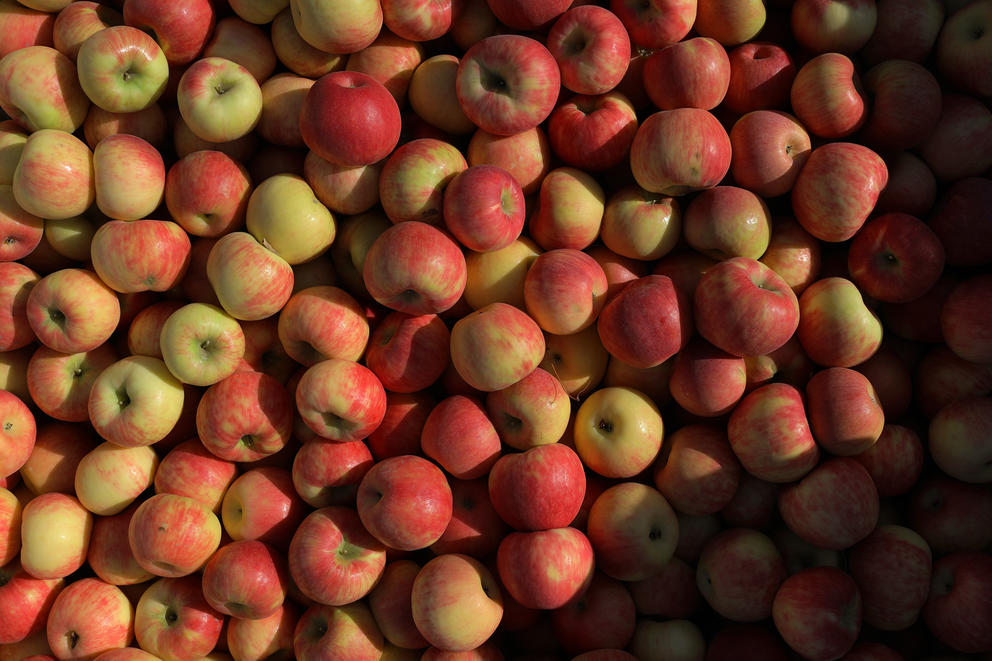In August, the Washington State Tree Fruit Association anticipated this year’s fresh apple crop will be just over 134 million 40-pound boxes. That’s a 29% increase from only 104.3 million boxes in 2022 and 5% above the six-year average yield.
A grower survey, released in late September and based on the results of the early harvest, found 2023 may even exceed the initial estimate, said Jon DeVaney, president of the Washington State Tree Fruit Association.
“To go down to 104 million was a big drop-off,” DeVaney said. “We’re back to more of the normal range, which is good news for our growers and anyone who likes to eat apples.”
Apples are Washington’s top-value agriculture commodity. Even with a lower-volume yield, the 2022 apple crop still had a value of nearly $2 billion, according to figures from the U.S. Department of Agriculture’s National Agricultural Statistics Service. Washington apple growers produce more than 60% of U.S. apples.
Varieties
With yields expected to make up 20%, or about 26.5 million boxes, of the total crop, Gala remains the top apple variety in Washington, a title it took from Red Delicious several years ago.
But the most significant increase in volume came from Honeycrisp, which has gained a strong following over the past two decades. The August estimate predicted that 14.6% of the crop, or 19.6 million boxes, would be Honeycrisp, making it the second-highest variety. The September survey indicates a 13.8% increase in yields from the earlier estimate.
“It’s an indication of how much ongoing enthusiasm there has been for that variety,” DeVaney said.
Meanwhile, production of Cosmic Crisp, the new and well-publicized variety developed by Washington State University’s apple breeding program, also continues to increase. Cosmic Crisp, formed by crossbreeding Honeycrisp and Enterprise, is expected to make up about 5.9% of the crop, or about 7.9 million boxes.
As in past years, the new crop of Cosmic Crisp won’t be available in stores until early November. The aim is to allow recently picked apples time to develop sugars while stored at warehouses.
Red Delicious is projected to make up 13% of the 2023 crop, far from the two-thirds or more it made up two to three decades ago.
It’s unlikely that any variety now or in the future will dominate like Red Delicious did decades ago, DeVaney said.
Other expected top apple varieties are Granny Smith at 13.8% and Fuji at 11.7%.
Another notable development is the continued growth in organic apples, DeVaney said. The Washington State Tree Fruit Association projected a few months ago that 15.7% of the crop is growing organically this year. More growers have devoted a portion of their production to organic as they can earn more per apple compared to non-organic fruit, DeVaney said.
“Over the last couple of decades — 10 to 20 years — the gap between conventional and organic practices has narrowed significantly,” he said, noting that it’s now easier to get acreage certified organic.
Exports
The Washington apple industry is rebuilding its export market. In the past, the state exported roughly 30% of its apples.
That figure has dropped to closer to 25% in recent years as tariffs and supply chain issues have made it challenging to access some foreign markets, DeVaney said. In 2022, just 20% of the state’s apple crop was exported.
Several recent developments may help increase exports this year and in the coming years. The most notable change came in June when India lifted a 20% apple tariff, which had been implemented in 2019 in retaliation for U.S. tariffs on steel and aluminum imports. The tariff caused apple exports to India to drop from $120 million annually to just under $3 million last year, according to a letter sent to U.S. trade officials by Washington’s Congressional delegation earlier this year.
India also was a top buyer of Red Delicious. With the variety falling out of favor with U.S. consumers, most Red Delicious now head overseas.
DeVaney said it would take time to rebuild market share in India, especially as other apple-growing countries will not easily relinquish sales they gained while the tariff was in place for U.S. apples. However, he’s heard from tree-fruit sales managers that there have been recent inquiries and interest from India.
“To win back business … you really have to work to get [India] to change their buying behavior,” he said.



